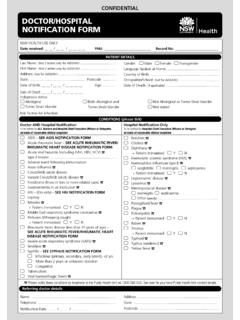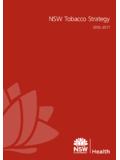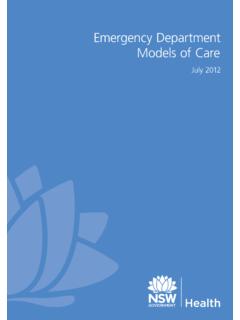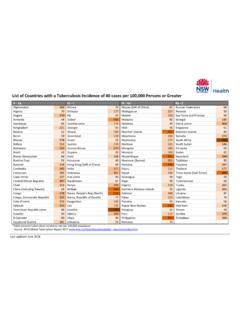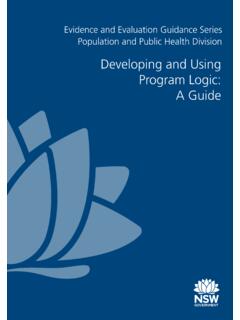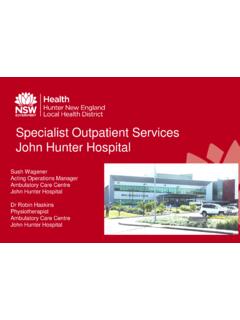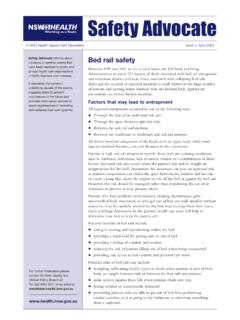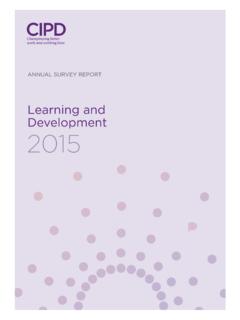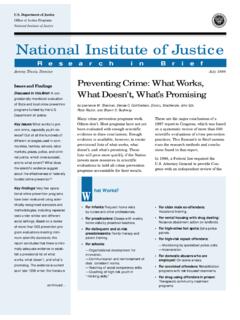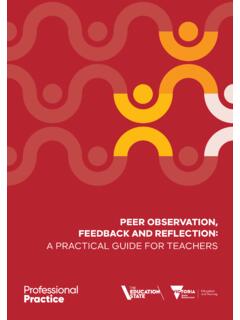Transcription of Developing and Using Program Logic: A Guide - NSW Health
1 Evidence and Evaluation Guidance SeriesPopulation and Public Health DivisionDeveloping and Using Program Logic: A Guide2 NSW Health Developing and Using Program logic : A GuideCENTRE FOR EPIDEMIOLOGY AND EVIDENCE NSW Ministry of Health Locked Mail Bag 961 North Sydney NSW 2059 Copyright NSW Ministry of Health 2017 This work is copyright. It may be reproduced in whole or in part for study and training purposes subject to the inclusion of an acknowledgement of the source. It may not be reproduced for commercial usage or sale. Reproduction for purposes other than those indicated above requires written permission from the NSW Ministry of (CEE) 170069 ISBN 978-1-76000-601-3 (Print) ISBN 978-1-76000-602-0 (Online)Contributors to the development of the Guide : Danielle Campbell, Barry Edwards, Beth Stickney, Teresa Wozniak, Andrew MilatSuggested citation:Centre for Epidemiology and Evidence.
2 Developing and Using Program logic : A Guide . Evidence and Evaluation Guidance Series, Population and Public Health Division. Sydney: NSW Ministry of Health , copies of this document can be downloaded from the NSW Health website 2017 Contents1. Introduction 42. What is Program logic ? 43. Why develop a Program logic model? 54. When to develop Program logic 55. Developing Program logic 6 5 .1 Getting started 6 Developing a Program logic model 6 Representing Program logic 106.
3 How can Program logic be used? 13 6 .1 Using Program logic to plan a Program evaluation 137. Conclusion 158. Useful resources 159. References 16 NSW Health Developing and Using Program logic : A Guide 3 NSW Health is committed to the development of evidence based policies and programs and the ongoing review and evaluation of existing programs . This Guide has been developed to support NSW Health staff in the development of Program logic and its use in informing population Health Program planning, implementation and Guide promotes a planned and structured approach to Developing Program logic and includes information on: the meaning and purpose of Program logic when and how to develop Program logic how Program logic can be used, with a particular focus on planning an Program logic model is a schematic representation that describes how a Program * is intended to work by linking activities with outputs, intermediate impacts and longer term outcomes.
4 Program logic aims to show the intended causal links for a different terms are used to describe Program logic , such as Program theory, logic model, theory of change, results chain and intervention logic . 1. Introduction2. What is Program logic ?* The NSW Government Program Evaluation Guidelines define a Program as a set of activities managed together over a sustained period of time that aim to achieve an outcome for a client or client group (p. 4). The Guidelines use Program to refer to policy, strategy, initiative, service or project. This Guide also uses the term intervention as an alternative to Program .14 NSW Health Developing and Using Program logic : A Guide3.
5 Why develop a Program logic model? Using a Program logic approach to describe a Program has many benefits. For example: Having an agreed Program logic model supports a systematic and integrated approach to Program planning, implementation and A Program logic model tells the story of how the Program is proposed to work. By clarifying activities and intended outcomes, a Program logic model illustrates the change processes underlying a ,4 Program logic makes Program assumptions explicit and enables testing of how these assumptions are supported by ,5 Program logic is a useful tool for engaging stakeholders in Program planning and evaluation, and clearly communicating with stakeholder audiences about Program A Program logic model agreed with key stakeholders can facilitate common language about the Program and build a shared understanding of how it will.
6 5 Program logic provides a framework for evaluating a Program by identifying areas where evaluation will be most important, and informing the development of meaningful evaluation When to develop Program logicIdeally, Program logic should be developed in the Program planning stage. This allows stakeholders to articulate the desired Program impacts and outcomes, and clarify how the intervention will achieve these. Note that Program logic does not replace a Program plan, but rather informs it; a Program plan generally has more detailed steps and Program logic may be reviewed and refined at different times, including during implementation and as part of planning a Program logic can also be developed for an existing Program , although this may be more difficult, particularly where the Program is complex or has multiple unrelated components.
7 Fitting a Program logic model onto an existing Program can enable stakeholders to consider whether the outputs and impacts identified through the Program logic match what the Program is delivering, and amend the Program implementation Health Developing and Using Program logic : A Guide 55 .1 Getting startedDeveloping Program logic is a participatory and iterative exercise. The NSW Government Evaluation Toolkit describes the process as partly analytical and partly Analytically, it involves review of the Program to identify aims, objectives, activities and intended impacts/outcomes, and refining and assembling these statements into a causal chain that shows how the activities are assumed to contribute to short-term and intermediate impacts and, ultimately, to longer term outcomes.
8 During this stage it is important to closely examine and question the assumptions underlying the Program components and causal chain so that any unintended or unforeseen consequences can be anticipated,7 and outcomes can be fairly attributed to the , the process of Developing Program logic should involve working with a range of stakeholders to draw on their understanding of the Program and its impacts/outcomes. Engaging stakeholders also has the benefit of encouraging ownership of the final Program logic Decisions about which stakeholders to involve and the nature of their involvement will depend on how the Program logic will be used. For instance, if the Program logic is intended to develop an understanding of what is needed to make a Program work, it is important to involve Program clients and partner agencies; if the Program logic will be used to design an evaluation, Program staff and management involvement is logic development is often undertaken in a workshop format to engage relevant stakeholders.
9 Alternatively or in addition to a workshop, structured interviews may be conducted with stakeholders to elicit their understanding of the problem being addressed by the Program , its causes and consequences, and how the Program will contribute to addressing the Developing a Program logic modelThere are many ways to develop Program logic . The BetterEvaluation website lists several approaches, including articulating mental models by talking with key informants individually or in groups about how they understand an intervention works; SWOT analysis to assess the Strengths, Weaknesses, Opportunities and Threats of a Program to determine how it might best be implemented; or backcasting.
10 9 Backcasting is a useful approach that involves identifying the long-term outcomes of a Program and subsequently working backwards to identify the necessary steps required to achieve these outcomes. The benefit of backcasting, compared to approaches involving forecasting, is that it allows stakeholders to consider what is needed to create the future, rather than thinking about what is currently happening and trying to predict the steps for Developing a Program logic model Using the backcasting approach are outlined as Developing Program logic6 NSW Health Developing and Using Program logic : A GuideStep 1: Develop an outcomes hierarchy An outcomes hierarchy, sometimes referred to as an outcomes chain, shows the assumed cause-and-effect relationships between Program outcomes, from immediate and short-term impacts to long-term outcomes.
